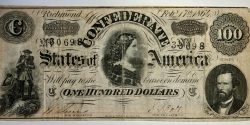Past, Present, and Faulkner
Past, Present, Faulkner
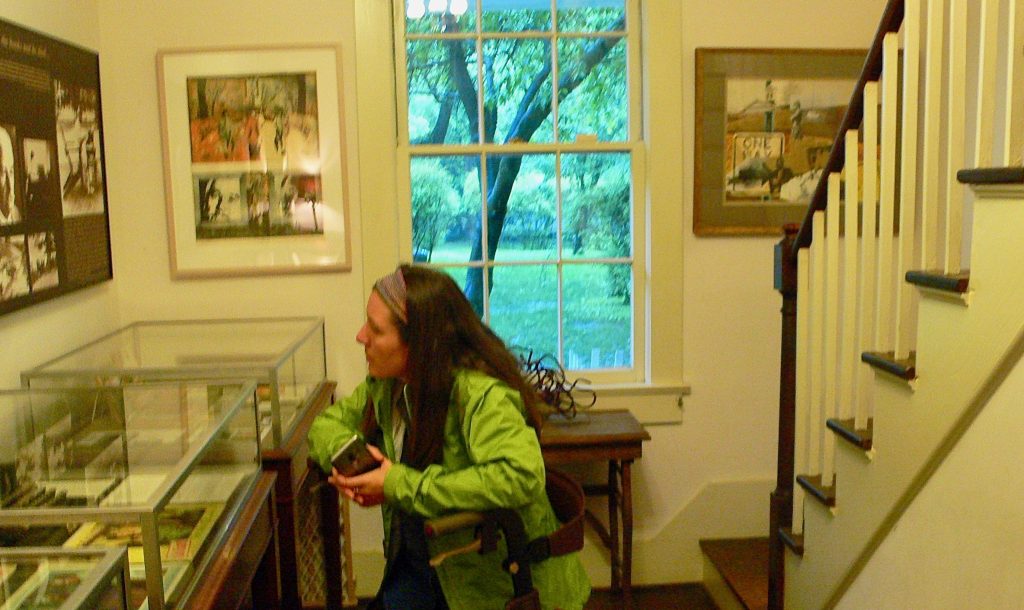
“My fellow citizens,” Abraham Lincoln said, addressing Congress in December 1863. “We cannot escape history.” The sentiment and, “The past never dies. It is not even past,” a line from William Faulkner that has been elevated by quote pickers to the status of an aphorism about the South, hummed like a soundtrack in my mind as we (my daughter and I) discovered the state of Mississippi. Don’t forget slavery, the bluesy background kept repeating. Don’t forget the violence of the 1960’s.
She was not even born then, but I did not have to tell her about Mississippi Burning: the KKK at night, the exonerated murders of Emmett Till, Medgar Evers, Chaney-Goodman-Schwerner. The endless anniversaries attract the media. They become news, affordable to produce from the archives. Not even the past.
We went to Natchez because I wanted to drive some of the Natchez Trace Parkway that goes 444 miles to Nashville and look for signs of the original wagon road. I like historic trails. Old spirits follow them, and you can find things. In arid northern New Mexico I have seen 150-year-old wagon tracks from the Old Santa Fe Trail and found a rusty spur.
Now, Natchez is a leafy little town on a bluff of the Mississippi river. Population 15,000, down from 22,000 in 1980 when there was a tire factory and a pulp mill. There are no big employers now, just tourist attractions and real estate bargains and a posh casino on a permanent steamboat.
The racial divide in Natchez is African American 60 per cent, Anglo American 36 percent — the reverse of the statewide percentages. Natchez has had black mayors since 2004. Billboards were advertising a stern black candidate running for sheriff against the incumbent, also African American. The city still promotes 19 accessible antebellum mansions. Yes, they were built before the civil war by wealthy slave owners. Their architecture is mostly brick walls elaborate white porticos and classical white columns supporting long second-story galleries. The style is called Greek revival (I recalled the Athenians had slaves.)

Inside one mansion, called Auburn, is a self-supporting double-helix stairway that makes two full turns. It stands by itself like a stretched coil spring. The hand rail is a continuous bend of dark wood. I was surprised because I thought the only such woodwork masterpiece is the “Miraculous Staircase” in Santa Fe’s Loretto Chapel. I took a picture and posted it for the enlightenment of friends in New Mexico, where I worked for a long time.
So why is not the Natchez staircase famous too? Well, tourism depends upon stories, or histories. Tourists (like we journalists) go out and bring back stories — with pictures. The Loretto Chapel story is mysterious and sweet. The Auburn mansion story is not.
Loretto was consecrated in 1878, but there was an unsolved architectural problem, and the architect had died. The choir loft was left hanging 20 feet above the floor with no access. Choirs don’t usually climb ladders. There was no space in the narrow chapel for ordinary stairs. The nuns prayed and prayed. Along came a mysterious stranger. He built the double helix staircase using simple hand tools and wood-peg joinery. And then he vanished, leaving no name.
Auburn was built 70 years earlier by a politician who became state attorney general, but it soon passed to a doctor named Stephen Duncan who arrived from Pennsylvania in 1809 and got into investment and banking. By 1850 he owned numerous plantations and a thousand slaves. He was not alone among slaveholders on the Natchez bluff. A common estimate is there were more millionaires there before the civil war than in New York City.
Most of their plantations were across the river, in the Louisiana flats. Our host at a luxurious bed and breakfast mansion on the Natchez Trace Parkway made an interesting point at the formal breakfast table one morning. He said the popular image from the movies of plantation homes with a tree-lined lanes is misleading. The plantation residences were “farmhouses.” The owner-planters lived with their families in town — in showplaces with halls like ballroom floors where they entertained and the men did business and politics.
In other words, the wealthy planters kept their distance from their slaves and overseers. It occurred to me that this distancing is a factor in the extraordinary shame of American slavery.
I mean, slaves going back to even the Old Testament may have been treated differently. A scholar of colonial slavery in Louisiana, Gwendolyn Midlo Hall, writes that the French, who colonized New Orleans in 1718,

did not consider Africans as “uncivilized.” She says, “French New Orleans was a brutal, violent place. But it cannot be understood by projecting contemporary attitudes toward race backward in time. There is no evidence of racial exclusiveness and contempt that characterizes more recent times.”
There it is: contempt. It explains the violent resistance to integration a century after the civil war and the legacy of white supremacy now. In the civil rights era the KKK was revived in Natchez. Two car bombings — one that critically injured the head of the local NAACP, one that killed a black worker the day after he was promoted to a traditionally white management position — spurred African Americans to take up arms. The governor called out the national guard.
And so goes one simple explanation (there are others) why beautiful historic Natchez on the Mississippi is not flourishing. The shame of slavery with its legacy is not even the past.
This was one of the refutations of current dismissive attitudes from a white graduate student who guided our tour group at Whitney Plantation in Louisiana, the only antebellum plantation focused on the slaves. It is a private property bought and restored by a Louisiana lawyer-developer using $8 million of his own money and open to the public since 2014. The guide said those who want to ignore slavery because all that stuff was long ago and far away are blind the the legacy of the “slave society” that involved everybody including righteous preachers, northern politicians and eastern bankers.
She said the argument that some slaves were well treated is unsupported. She said the revolt by enslaved Africans against the French colonists that resulted in the establishment of Haiti as free nation in 1791 is downplayed because the Haitian revolution so disturbed the American planters that they turned to discipline by terror. She said the story that house servants enjoyed their superior positions fails to acknowledge that they were isolated from their African community and that a slave in the house was in constant contact with the masters and therefor subject to harassment and their intermittent moods.
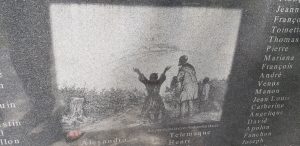 The centerpiece of Whitney is a lane of granite placards with quotes and engraved scenes and the hundreds of names of slaves who had lived there. Single common names. Slaves had no family names. They not only had been ripped from their African families, wholesale, but their American families were ripped apart, retail. On the granite are quotes evoked in the 1930’s by the Federal Writers Project from old people born into slavery:
The centerpiece of Whitney is a lane of granite placards with quotes and engraved scenes and the hundreds of names of slaves who had lived there. Single common names. Slaves had no family names. They not only had been ripped from their African families, wholesale, but their American families were ripped apart, retail. On the granite are quotes evoked in the 1930’s by the Federal Writers Project from old people born into slavery:
“Every body worked, young and ole; if you could only carry two or three sugar cane, yo’ worked. No school, no church. An’ Saturday night dey always have a dance, but yo’ worked. Yo’ has to put yo’ candle out early and shut yo’self up, den get up while it’s still dark an’ start to work.”
“Dey didn’t larn us nothin’ an didn’t ‘low us to larn nothin.’ Iffen dey ketch us larnin’ to read an’ write, dey cut us han’ off.”
“Tisn’t he who has stood and looked on that can tell you what slavery is — ’tis he who has endured.”
The restoration includes a clapboard church, among the windowless and doorless mass slave cabins, built in 1870 in the Protestant movement to Christianize freed African Americans, who by then were free laborers 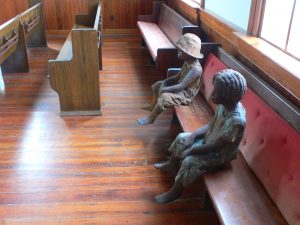 living on sustenance wages with nowhere else to go. The plantation church is populated by life size models of curious sad wary children.
living on sustenance wages with nowhere else to go. The plantation church is populated by life size models of curious sad wary children.
There are no quotes from the elite in the mansions, but I am sure they would have talked something like the wife of a Boston banker visiting American-supported Cuban plantations quoted in the history of Cuban slavery, No God But Gain:
“The conversation in most companies consists of the price of slaves. ‘Such a day, a fine cargo of negroes arrived from the coast of Guinea. Have been to see them, they are fine looking felons. What will they sell for?’”
After hurricane Katrina, I read, there was opposition to repairing damaged antebellum mansions, and some commenters on travel web sites criticize the exclusive mansion tours. Still, at the Auburn mansion, amiable women of the Natchez Garden Club greet you and proudly show you around, speaking of interior decoration, historic furnishings and fashionable quadrilles. They point out that the adjacent 280-acre Duncan park was donated to the city by the Duncan heirs. And they display a letter written in 1876 about the estate’s horses in a fine script by the black butler to the absent owner.
The salutation is “Dear Master Steve,” and the ending is, “I feel grateful for the confidence reposed in my integrity and I shall endeavor to deserve it.” Signed, “I am your obedient / and a name.
At Rosalie mansion, named for the historic Fort Rosalie nearby, members of the DAR show priceless furnishings and describe the architect’s design for cooling by natural air circulation. They tell a nicer than usual story about this mansion’s builder, Peter Little, who arrived from Pennsylvania (another midwesterner) at age 18 in 1798, seeking work as a laborer. He bought land and a couple of slaves, immediately selling one at a loss and freeing the other. Eventually he bought a derelict river boat and began his fortune by adapting its steam engine to run a circular saw, producing lumber from the ancient cypress trees in the Louisiana bayous. (Dark side: those redwood-like trees were home to birds that ate billions of mosquitos that were vectors for yellow fever.)
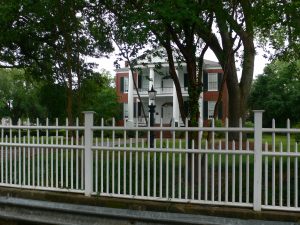
He became friends in his daily crossings of the river with the ferryman, who, along with his wife, was infected in the yellow fever epidemic of 1805. Before they died they pleaded with Little to take care of their 13-year-old daughter, Eliza. He did — marrying her three years later, sending her to school in Baltimore, outfitting her with the best clothes from New Orleans when she returned as a refined adult, and introducing her to society. He built the Rosalie mansion for her in 1820-23. Little did not become a slave-owning planter until his lumber business made him rich. He and Eliza lived at Rosalie childless but happily until their deaths shortly before the Civil War, the story goes.
Peter Little is like Thomas Sutpen in Faulkner’s Absalom, Absalom! Except Sutpen is evil and there is no happily-everafter ending. I decided to understand both as fictions telling their own truths.
In an irony of the civil war, for a while in 1863 an upstairs Rosalie bedroom with a window looking down on a reach of the river was occupied by Union Gen. Ulysses S. Grant. The mayor of Natchez had surrendered rather than suffer the fate of Vicksburg, ruined by the cannons of Grant’s new iron-clad river boats and besieged for nearly two months.
Still, most wealthy Natchez survivors of the war lost their plantations and some, their mansions. Dr. Duncan, top nabob with the most slaves to his name but never a supporter of the Confederacy, kept Auburn but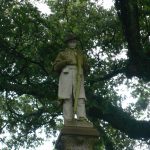 moved to New York City, where he continued banking and investing. For a while he worked on an unsuccessful project to send freedmen to Canada. The enlisted and often drafted Confederate soldiers, most not even slave owners, suffered the most. Although they were released with their possessions, even their horses, under Gen. Robert E. Lee’s surrender agreement with Grant at Appomattox, they went home to the poverty of the Reconstruction era as the nation industrialized but the South was left behind. There’s one of them, a common soldier, atop an 1890 memorial to the local Confederate dead in Veteran’s Park near the cathedral in downtown Natchez. His rifle and his face hang down sadly. I wondered who among those who now revile Confederate monuments would want to remove him?
moved to New York City, where he continued banking and investing. For a while he worked on an unsuccessful project to send freedmen to Canada. The enlisted and often drafted Confederate soldiers, most not even slave owners, suffered the most. Although they were released with their possessions, even their horses, under Gen. Robert E. Lee’s surrender agreement with Grant at Appomattox, they went home to the poverty of the Reconstruction era as the nation industrialized but the South was left behind. There’s one of them, a common soldier, atop an 1890 memorial to the local Confederate dead in Veteran’s Park near the cathedral in downtown Natchez. His rifle and his face hang down sadly. I wondered who among those who now revile Confederate monuments would want to remove him?
Before leaving town, we went to a Natchez park to see the “mounds,” built by the Natchez natives, who were dominant in the lower Mississippi valley from about 700 to 1500. In the museum we saw their pottery with incised complex designs. A video said they farmed, planting corn, beans and squash and their kinship organization was matrilineal — the same as the historic pueblos and their Anasazi ancestors in the dry Southwest. I wondered if there was prehistoric contact between these civilizations.

The two original populations of Natchez and Santa Fe entered history with something else in common: both were colonized by European Catholics, the Natchez by the French, the Pueblo people by the Spanish. And both rebelled violently after initial accommodation of the invaders. Under the American successors, even now include conservatives in both Natchez and Santa Fe will talk with regret about an “invasion” by the Yankee United States. In Santa Fe it was Stephen Kearney in 1846. In Natchez it was Grant in 1863. African Americans are not part of this complaint, of course. But I wondered if they someday may unite politically, not with the conservative New Mexico hispanics, but with American Latinos, or Chicanos, in general.
One night we found the only super market in Natchez at closing time. Out on the huge strip-mall parking lot several hundred young people were partying. Mariachi music blared from the brightely lighted Mexican restaurant that was the focal point of the crowd. The supermarket manager stood just inside his doors watching the crowd. He warned us he would close in ten minutes. I asked him what was going on out there.
“Cinco de Mayo,” he said.
What? A celebration of Mexican independence in a town that is about 1 per cent Latino?
Oh, I saw: these partiers were not speaking Spanish. Nor were they traditional white Southern parking lot partiers.
When we got back with some groceries, there was another car parked close to ours, leaving only about two feet on the passenger side. Some young men were looking out open windows and talking to a pretty girl.
She, the black girl, cleared the way for us and said to me, “What’s your name?”
“My name? Lorenzo,” I said sarcastically. She laughed, and I said, “What’s yours?”
She told me. She raised her right hand.
High five! Her hand was warm.

